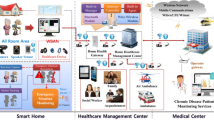Abstract
Diabetes therapy management in AAL environments, such as old people and diabetes patients homes, is a very difficult task since many factors affect a patient’s blood sugar levels. Factors such as illness, treatments, physical and psychological stress, physical activity, drugs, intravenous fluids and change in the meal plan cause unpredictable and potentially dangerous fluctuations in blood sugar levels. Right now, operations related to dosage are based on insulin infusion protocol boards, which are provided by physicians to the patients. These boards are not considering very influential factors such as glycemic index from the diet, consequently patients need to estimate the dosage leading to dose error, which culminates in hyperglycemia and hypoglycemia episode. Therefore, right insulin infusion calculation needs to be supported by the next generation of personal-care devices. For this reason, a personal device has been developed to assist and consider more factors in the insulin therapy dosage calculation. The proposed solution is based on Internet of things in order to, on the one hand, support a patient’s profile management architecture based on personal RFID cards and, on the other hand, provide global connectivity between the developed patient’s personal device based on 6LoWPAN, nurses/physicians desktop application to manage personal health cards, glycemic index information system, and patient’s web portal. This solution has been evaluated by a multidisciplinary group formed by patients, physicians, and nurses.











Similar content being viewed by others
References
Diabetes Control and Complications Trial Group (1977) The effect of intensive treatment of diabetes on the development and progression of long-term complications in insulin-dependent diabetes Mellitus. N Engl J Med 329:977–986
Bhargava A (2005) Insulin therapy. Insulin J 4(1):68–69
Berghe GV (2004) How does blood glucose control with insulin save lives in intensive care?. J Clin Investig 114(9):1187–1195
Lehmann ED (1997) Interactive educational simulators in diabetes care. Med Inform 22:47–76
Smith BK, Frost J, Albayrak M, Sudhakar R (2007) Integrating glucometers and digital photography as experience capture tools to enhance patient understanding and communication of diabetes self-management practices. Pers Ubiquitous Comput 11:273–286
Istepanian RSH, Zitouni K, Harry D, Sungoor A, Tang B, Earle KA (2009) Evaluation of a mobile phone telemonitoring system for glycaemic control in patients with diabetes. J Telemed Telecare 15:125–128
Villarreal V, Laguna J, López C, Fontecha J, Fuentes C, Hervás R, López-de-Ipiña D, Bravo J (2009) A proposal for mobile diabetes self-control: towards a patient monitoring framework. IWANN 2:870–877
Jara AJ, Istepanian RSH, Sungoor A, Alcazar N, Zamora M, Skarmeta AFG (2010) Diabetes management and insulin therapy in the hospital and AAL environments based on mobile health. II international workshop on ambient assisted living, Valencia, Spain
Earle KA, Istepanian RSH, Zitouni K, Sungoor A, Tang B (2010) Mobile telemonitoring for achieving tighter targets of blood pressure control in patients with complicated diabetes: a pilot study. Diabetes Technol Ther 12(7):575–579. http://dx.doi.org/10.1089/dia.2009.0090
Istepanian RSH, Jara A, Sungoor A, Philips N (2010) Internet of things for M-health applications (IoMT). AMA-IEEE medical technology conference on individualized healthcare, Washington
Zamora Izquierdo MA, Santa Lozano J, Antonio F, Gómez Skarmeta (2010) An integral and networked home automation solution for indoor ambient intelligence. IEEE Pervasive Comput 9:66–77
Babic B, Nicoletta M, Martin L (2010) Manual de Conteo de Hidratos de Carbono. ADU Uruguay Diabetes Association
Jara AJ, Alcolea AF, Zamora M, Skarmeta AFG (2010) Analysis of different techniques to define metadata structure in NFC/RFID cards to reduce access latency, optimize capacity, and guarantee integrity. 10th IFAC workshop on intelligent manufacturing systems, Lisbon, Portugal
Tentori M, Favela J, González JM (2006) Quality of privacy (QoP) for the design of ubiquitous healthcare applications. J Univers Comput Sci 12(3):252–269
Jara AJ, Zamora MA, Skarmeta AFG (2009) NFC/RFID applications in medicine—security challenges and solutions, 5th international conference on intelligent environments, Barcelona, Spain
Ayuso J, Marin L, Jara AJ, Skarmeta AFG (2010) Optimization of public key cryptography (RSA and ECC) for 8-bits devices based on 6LoWPAN. First international workshop on the security of the internet of things, Tokyo, Japan
Acknowledgments
The authors would like to thank the Spanish ministry for Industry, Tourism and infrastructure, and the ministry for education, social politic and sport for sponsoring the research activities under the grants AIRE (TSI-020302-2010-95) and FPU program (AP2009-3981). This work has been carried out by the Intelligent Systems group of the University of Murcia, awarded as an excellence researching group in frames of the Spanish “Plan de Ciencia y Tecnología de la Región de Murcia” from the “Fundación Séneca” (04552/GERM/06). Finally, thanks to the volunteers, who evaluated this solution, nurses, and physicians: Noemí Alcazar, Fermín Alcolea, José Javier Campuzano, and María Jesús Carrillo, and to the patients: José García and Belinda Herrero.
Author information
Authors and Affiliations
Corresponding author
Rights and permissions
About this article
Cite this article
Jara, A.J., Zamora, M.A. & Skarmeta, A.F.G. An internet of things–based personal device for diabetes therapy management in ambient assisted living (AAL). Pers Ubiquit Comput 15, 431–440 (2011). https://doi.org/10.1007/s00779-010-0353-1
Received:
Accepted:
Published:
Issue Date:
DOI: https://doi.org/10.1007/s00779-010-0353-1




